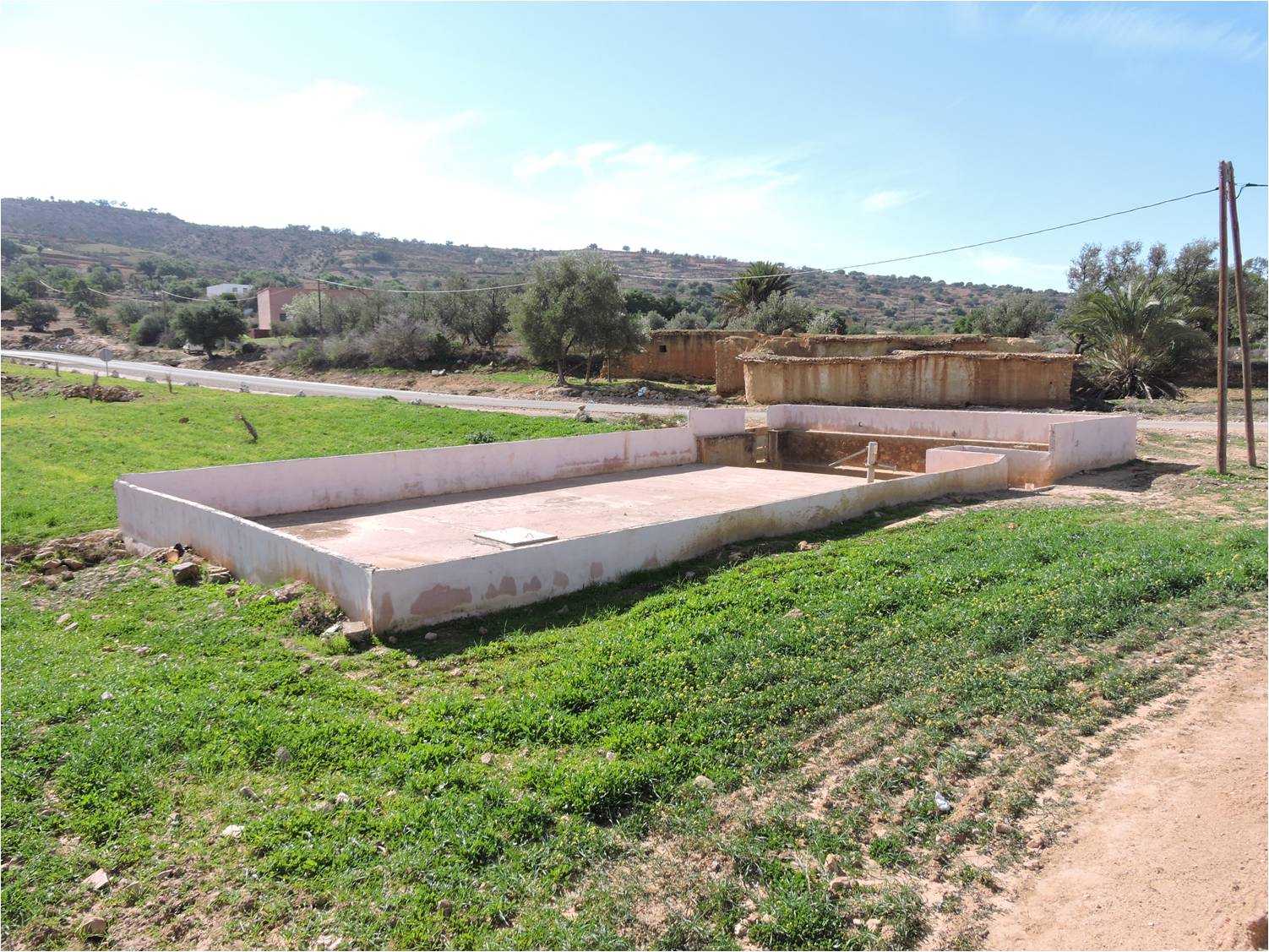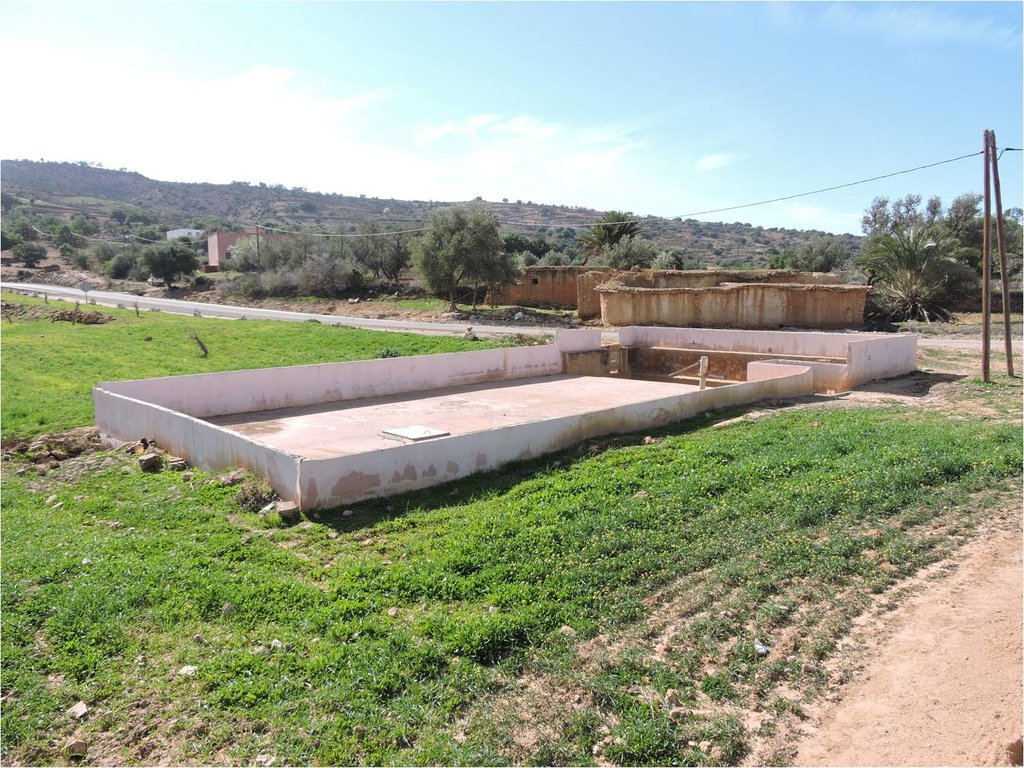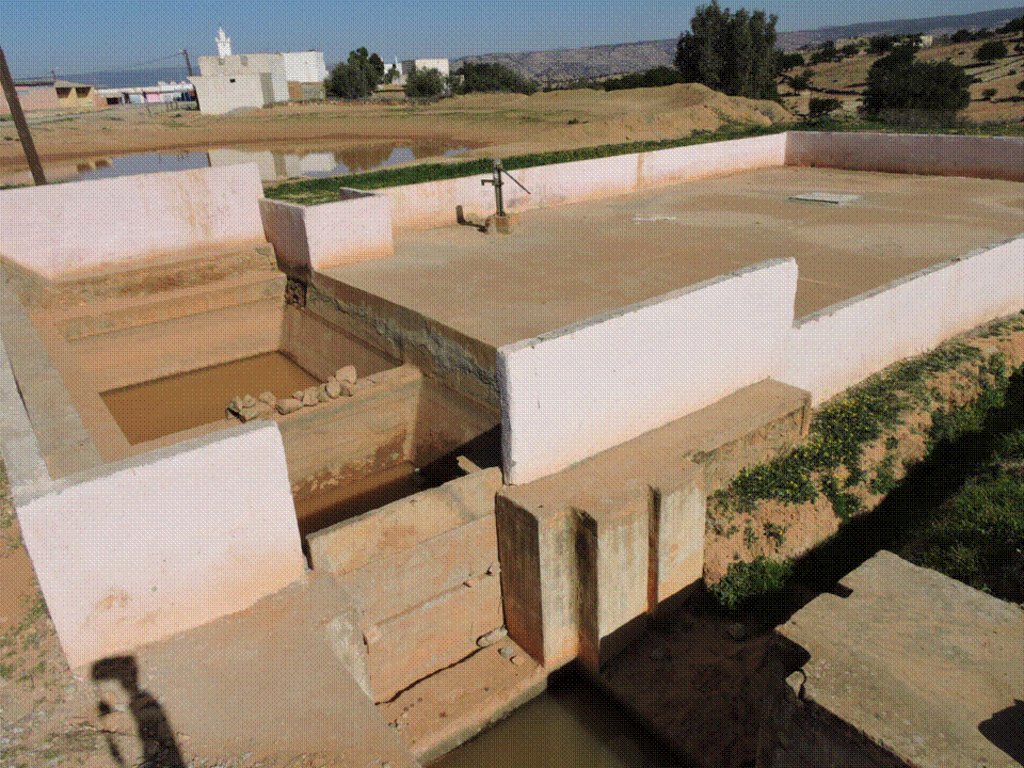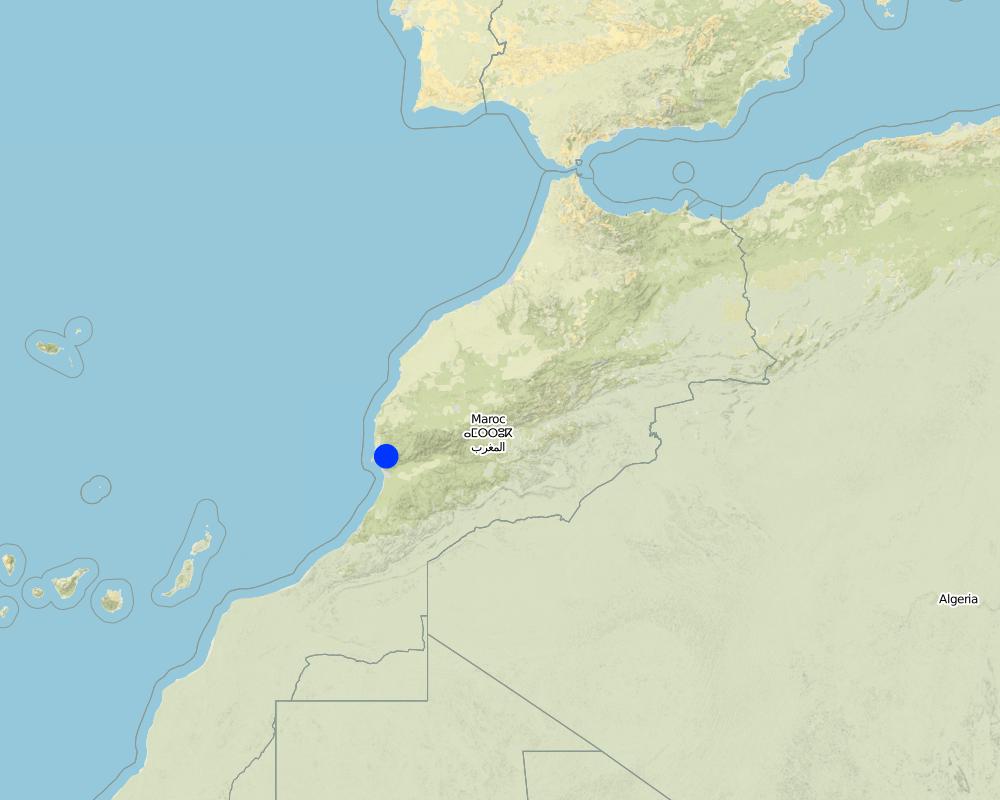Citerne [Morocco]
- Creation:
- Update:
- Compiler: Mohamed Sabir
- Editor: –
- Reviewers: Donia Mühlematter, Rima Mekdaschi Studer, Nicole Harari
Matfia
technologies_3205 - Morocco
View sections
Expand all Collapse all1. General information
1.2 Contact details of resource persons and institutions involved in the assessment and documentation of the Technology
SLM specialist:
land user:
Ait Salah Mohamed
Douar Takoucht, Commune Ameskroud, Province Agadir.
Morocco
Name of project which facilitated the documentation/ evaluation of the Technology (if relevant)
Decision Support for Mainstreaming and Scaling out Sustainable Land Management (GEF-FAO / DS-SLM)Name of the institution(s) which facilitated the documentation/ evaluation of the Technology (if relevant)
Royaume du Maroc, Haut Commissariat aux Eaux et Forêts et à la Lutte Contre la Désertification (Royaume du Maroc) - Morocco1.3 Conditions regarding the use of data documented through WOCAT
When were the data compiled (in the field)?
12/01/2017
The compiler and key resource person(s) accept the conditions regarding the use of data documented through WOCAT:
Ja
1.4 Declaration on sustainability of the described Technology
Is the Technology described here problematic with regard to land degradation, so that it cannot be declared a sustainable land management technology?
Nee
1.5 Reference to Questionnaire(s) on SLM Approaches
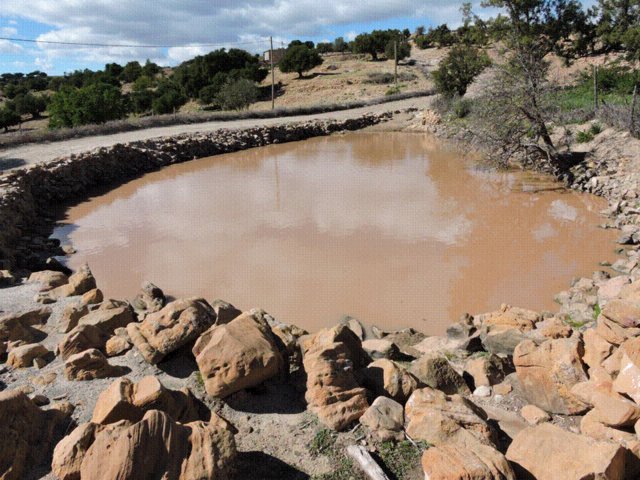
Collecte Eau Pluviale [Morocco]
La collecte des eaux pluviales permet de mobiliser l'eau et le rendre disponible pour les villageaois dans une zone semi-aride pour les usages domestiques et d'élevage. Elle est issue du savoir faire paysan.
- Compiler: Mohamed Sabir
2. Description of the SLM Technology
2.1 Short description of the Technology
Definition of the Technology:
La Matfia est une citerne traditionnelle de stockage d'eau de pluie pour usage domestique.
2.2 Detailed description of the Technology
Description:
La Matfia est une citerne de stockage d'eau de pluie utilisée dans les zones arides et semiarides où l'eau est rare. Elle continue à être d'usage dans les douars (villages) enclavés et où la pauvreté est élevée.
C'est une citerne couverte de dimensions variables (dizaines à centaines de m3) qui reçoit les eaux provenant d'impluvium naturel ou artificiel (terrasses de maison, impluvium en béton, fossé de piste).
Elles sont construites en ciment ou en pierres ou taillées dans la roche mère. L'eau produite par l'impluvium est conduite souvent dans un déssableur avant d'entrer dans la citerne. Elles sont équipées d'un orifice de trop plein à l'aval.
La Matfia est un moyen de stocker de l'eau à usage domestique dans les endroits pauvres en ressouces hydriques naturelles. Il existe des Matfia privée à usage individuel et d'autres collectives à usage communautaire.
L'eau est utilisée essentiellement pour les besoins domestiques (boisson, cuisson, bains, ablutions).
Chaque ménage (famille) possède au moins deux à trois matfia pour couvrir les besoins annuels en eau. Un ménage de 6 personnes a besoin de 3 matfia de 30m3 (90m3)pour couvrir ses besoins annuels, surtout durant la saison sèche d'avril à octobre.
Une citerne familiale de 5x3x2=30m3 nécessite 5 000 à 10 000 MAD pour le creusement, 20 000 MAD pour la construction et 1 à 1,5 journées MO pour l'entretien chaque année avant la saison des pluies (1 m3 = environ 1000 MAD).
Ces citernes Matfia permettent aux paysans de vivre en montagne. Cependant, sans traitement l'eau est de mauvaise qualité.
2.3 Photos of the Technology
2.5 Country/ region/ locations where the Technology has been applied and which are covered by this assessment
Country:
Morocco
Region/ State/ Province:
Province d'Agadir
Map
×2.6 Date of implementation
If precise year is not known, indicate approximate date:
- more than 50 years ago (traditional)
2.7 Introduction of the Technology
Specify how the Technology was introduced:
- as part of a traditional system (> 50 years)
3. Classification of the SLM Technology
3.1 Main purpose(s) of the Technology
- adapt to climate change/ extremes and its impacts
- Mobiliser de la ressource eau pour les besoins domestiques.
3.2 Current land use type(s) where the Technology is applied

Settlements, infrastructure
- Mobiliser et stocker l'eau à usage domestique.
3.3 Further information about land use
Water supply for the land on which the Technology is applied:
- rainfed
3.4 SLM group to which the Technology belongs
- water harvesting
3.5 Spread of the Technology
Specify the spread of the Technology:
- applied at specific points/ concentrated on a small area
3.6 SLM measures comprising the Technology

structural measures
- S7: Water harvesting/ supply/ irrigation equipment
3.7 Main types of land degradation addressed by the Technology

other
Comments:
La matfia est destinée à mobiliser l'eau pour des usages domestiques. Elle ne traîte aucune dégradation des terres.
3.8 Prevention, reduction, or restoration of land degradation
Specify the goal of the Technology with regard to land degradation:
- not applicable
4. Technical specifications, implementation activities, inputs, and costs
4.1 Technical drawing of the Technology
4.2 Technical specifications/ explanations of technical drawing
Dimensions très variables: Volumes variables de 5 à plusieurs centaines de m3. Largeur : 2 à 10 m, Longeur: 2 à 30 m, Profonceur: 1 à 5 m.
Impluviums: Routes, pistes, Terrains tassés, Surface imperméabilisée, Terrasses de maisons.
La matfia collective est composée de : (1) Un impluvium naturel ou artificiel plus ou moins aménagé.
Le toit de la matfia (70 à 150 m2) peut être bétonné et utilisé comme impluvium, mais le plus souvent ce sont les eaux ruisselant des pistes et d'un petit versant qui sont captées; (2) Un canal (assarou, séguia) de raccordement entre l'impluvium naturel et la citerne; (3) Un ou deux bassins de décantation des sédiments, (4) Une conduite d'eau reliant le bassin de décantation à une ouverture perçant la dalle de la citerne et (5) Un orifice pour puiser l'eau, muni d'un couvercle en fer;
La matfia individuelle ou familiale est plus modeste: le toit de la maison joue le rôle d'impluvium. La citerne prend la forme d'un réservoir souterrain creusé dans la cour de la maison. Il est imperméabilisé avec de l'argile battue mélangée à la chaux ou avec du ciment.
4.3 General information regarding the calculation of inputs and costs
Specify how costs and inputs were calculated:
- per Technology unit
Specify unit:
Citerne de 30 m3
other/ national currency (specify):
Dirham marocain MAD
Indicate exchange rate from USD to local currency (if relevant): 1 USD =:
9.64971
Indicate average wage cost of hired labour per day:
70 MAD
4.4 Establishment activities
| Activity | Type of measure | Timing | |
|---|---|---|---|
| 1. | Creusement de la cavité de la citerne | Structural | Eté, automne |
| 2. | Construction de la citerne | Structural | Eté, automne |
4.5 Costs and inputs needed for establishment
If possible, break down the costs of establishment according to the following table, specifying inputs and costs per input. If you are unable to break down the costs, give an estimation of the total costs of establishing the Technology:
30200.0
| Specify input | Unit | Quantity | Costs per Unit | Total costs per input | % of costs borne by land users | |
|---|---|---|---|---|---|---|
| Labour | Ouvrier | JP | 60.0 | 70.0 | 4200.0 | |
| Labour | Ouvrier qualifié (Maalam) | JP | 50.0 | 120.0 | 6000.0 | 33.0 |
| Equipment | Matériaux de construction (Ciment , sable, etc.) | 1.0 | 20000.0 | 20000.0 | 66.0 | |
| Total costs for establishment of the Technology | 30200.0 | |||||
If land user bore less than 100% of costs, indicate who covered the remaining costs:
Des dons provenant de Services de l'Etat comme le HCEFLCD, l'Agriculture, la Commune.
4.6 Maintenance/ recurrent activities
| Activity | Type of measure | Timing/ frequency | |
|---|---|---|---|
| 1. | Curage annuel (début saison pluvieuse) | Management | Début automne |
4.7 Costs and inputs needed for maintenance/ recurrent activities (per year)
| Specify input | Unit | Quantity | Costs per Unit | Total costs per input | % of costs borne by land users | |
|---|---|---|---|---|---|---|
| Labour | Ouvrier | JP | 2.0 | 70.0 | 140.0 | 100.0 |
| Total costs for maintenance of the Technology | 140.0 | |||||
Comments:
Coût de l'entretien est pris en charge à 100% par les paysans.
4.8 Most important factors affecting the costs
Describe the most determinate factors affecting the costs:
Matériaux de construction et Main d'oeuvre.
5. Natural and human environment
5.1 Climate
Annual rainfall
- < 250 mm
- 251-500 mm
- 501-750 mm
- 751-1,000 mm
- 1,001-1,500 mm
- 1,501-2,000 mm
- 2,001-3,000 mm
- 3,001-4,000 mm
- > 4,000 mm
Specify average annual rainfall (if known), in mm:
250.00
Agro-climatic zone
- semi-arid
Précipitations très irrégulières.
5.2 Topography
Slopes on average:
- flat (0-2%)
- gentle (3-5%)
- moderate (6-10%)
- rolling (11-15%)
- hilly (16-30%)
- steep (31-60%)
- very steep (>60%)
Landforms:
- plateau/plains
- ridges
- mountain slopes
- hill slopes
- footslopes
- valley floors
Altitudinal zone:
- 0-100 m a.s.l.
- 101-500 m a.s.l.
- 501-1,000 m a.s.l.
- 1,001-1,500 m a.s.l.
- 1,501-2,000 m a.s.l.
- 2,001-2,500 m a.s.l.
- 2,501-3,000 m a.s.l.
- 3,001-4,000 m a.s.l.
- > 4,000 m a.s.l.
Indicate if the Technology is specifically applied in:
- not relevant
5.3 Soils
Soil depth on average:
- very shallow (0-20 cm)
- shallow (21-50 cm)
- moderately deep (51-80 cm)
- deep (81-120 cm)
- very deep (> 120 cm)
Soil texture (topsoil):
- coarse/ light (sandy)
Soil texture (> 20 cm below surface):
- coarse/ light (sandy)
Topsoil organic matter:
- high (>3%)
5.4 Water availability and quality
Ground water table:
> 50 m
Availability of surface water:
poor/ none
Water quality (untreated):
poor drinking water (treatment required)
Is water salinity a problem?
Nee
Is flooding of the area occurring?
Nee
Comments and further specifications on water quality and quantity:
L'eau est rare et variable entre les saisons sèches et humides. Elle varie aussi entre les années.
5.5 Biodiversity
Species diversity:
- high
Habitat diversity:
- medium
5.6 Characteristics of land users applying the Technology
Sedentary or nomadic:
- Sedentary
Market orientation of production system:
- subsistence (self-supply)
Relative level of wealth:
- very poor
- poor
Individuals or groups:
- individual/ household
- groups/ community
Gender:
- men
Age of land users:
- elderly
5.7 Average area of land owned or leased by land users applying the Technology
- < 0.5 ha
- 0.5-1 ha
- 1-2 ha
- 2-5 ha
- 5-15 ha
- 15-50 ha
- 50-100 ha
- 100-500 ha
- 500-1,000 ha
- 1,000-10,000 ha
- > 10,000 ha
Is this considered small-, medium- or large-scale (referring to local context)?
- small-scale
5.8 Land ownership, land use rights, and water use rights
Land ownership:
- communal/ village
- individual, not titled
Land use rights:
- open access (unorganized)
- communal (organized)
Water use rights:
- open access (unorganized)
- communal (organized)
5.9 Access to services and infrastructure
health:
- poor
- moderate
- good
education:
- poor
- moderate
- good
technical assistance:
- poor
- moderate
- good
employment (e.g. off-farm):
- poor
- moderate
- good
markets:
- poor
- moderate
- good
energy:
- poor
- moderate
- good
roads and transport:
- poor
- moderate
- good
drinking water and sanitation:
- poor
- moderate
- good
financial services:
- poor
- moderate
- good
6. Impacts and concluding statements
6.1 On-site impacts the Technology has shown
Socio-economic impacts
Water availability and quality
drinking water availability
drinking water quality
water availability for livestock
water quality for livestock
Socio-cultural impacts
health situation
cultural opportunities
community institutions
conflict mitigation
situation of socially and economically disadvantaged groups
Ecological impacts
Water cycle/ runoff
water quantity
water quality
Climate and disaster risk reduction
drought impacts
6.2 Off-site impacts the Technology has shown
water availability
6.3 Exposure and sensitivity of the Technology to gradual climate change and climate-related extremes/ disasters (as perceived by land users)
Gradual climate change
Gradual climate change
| Season | Type of climatic change/ extreme | How does the Technology cope with it? | |
|---|---|---|---|
| annual rainfall | very well | ||
| seasonal rainfall | summer | very well |
Climate-related extremes (disasters)
Climatological disasters
| How does the Technology cope with it? | |
|---|---|
| drought | very well |
6.4 Cost-benefit analysis
How do the benefits compare with the establishment costs (from land users’ perspective)?
Short-term returns:
positive
Long-term returns:
positive
How do the benefits compare with the maintenance/ recurrent costs (from land users' perspective)?
Short-term returns:
positive
Long-term returns:
positive
6.5 Adoption of the Technology
- more than 50%
Of all those who have adopted the Technology, how many have did so spontaneously, i.e. without receiving any material incentives/ payments?
- 90-100%
6.6 Adaptation
Has the Technology been modified recently to adapt to changing conditions?
Ja
If yes, indicate to which changing conditions it was adapted:
- climatic change/ extremes
Specify adaptation of the Technology (design, material/ species, etc.):
La matfia améliore fortement la disponibilité d'eau potable pour les paysans de ces zones arides et semi arides.
6.7 Strengths/ advantages/ opportunities of the Technology
| Strengths/ advantages/ opportunities in the land user’s view |
|---|
| La Matfia améliore fortement la disponibilité de l'eau potable pour les paysans de ces zones arides et semi arides. |
| Strengths/ advantages/ opportunities in the compiler’s or other key resource person’s view |
|---|
| La Matfia améliore la disponibilité de l'eau pour les paysans. |
6.8 Weaknesses/ disadvantages/ risks of the Technology and ways of overcoming them
| Weaknesses/ disadvantages/ risks in the land user’s view | How can they be overcome? |
|---|---|
|
Coût relativement élevé par rapport au niveau de vie des paysans. |
- Apport de l'émigration. - Travail en dehors de l'exploitation. |
| Weaknesses/ disadvantages/ risks in the compiler’s or other key resource person’s view | How can they be overcome? |
|---|---|
| Le coût de construction de ces structures est relativement élevé par rapport au niveau de vie des pysans (assez pauvres). |
Le travail en dehors des douars et de la région.(l'émigration des jeunes) permet de faire un apport consistant en argent aux douars. |
7. References and links
7.1 Methods/ sources of information
- field visits, field surveys
Plusieurs jours de prospection de terrain et rencontre de plusieurs personnes ressources des douars.
- interviews with land users
Rencontre des plusieurs personnes.
- interviews with SLM specialists/ experts
Rencontre des plusieurs personnes.
- compilation from reports and other existing documentation
7.2 References to available publications
Title, author, year, ISBN:
Éric Roose, Mohamed Sabir, Abdellah Laouina. 2010. Gestion durable de l'eau et des sols au Maroc. Valorisation des techniques traditionnelles méditerranéennes. IRD Éditions INSTITUT DE RECHERCHE POUR LE DÉVELOPPEMENT Marseille, 2010
Available from where? Costs?
http://horizon.documentation.ird.fr/exl-doc/pleins_textes/divers12-09/010054911.pdf
7.3 Links to relevant information which is available online
Title/ description:
Éric Roose, Mohamed Sabir, Abdellah Laouina. 2010. Gestion durable de l'eau et des sols au Maroc. Valorisation des techniques traditionnelles méditerranéennes. IRD Éditions INSTITUT DE RECHERCHE POUR LE DÉVELOPPEMENT Marseille, 2010
URL:
http://horizon.documentation.ird.fr/exl-doc/pleins_textes/divers12-09/010054911.pdf
Links and modules
Expand all Collapse allLinks

Collecte Eau Pluviale [Morocco]
La collecte des eaux pluviales permet de mobiliser l'eau et le rendre disponible pour les villageaois dans une zone semi-aride pour les usages domestiques et d'élevage. Elle est issue du savoir faire paysan.
- Compiler: Mohamed Sabir
Modules
No modules


